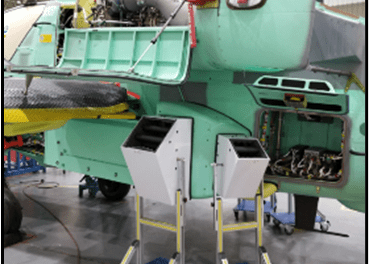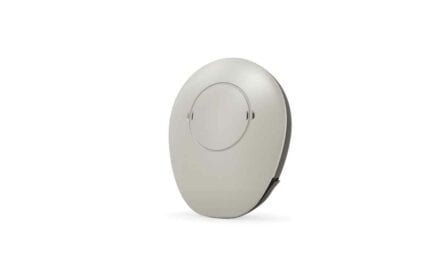Remember the Soundbite, the unique mouth-worn bone-conduction hearing device that resembled a dental bridge and was manufactured by Sonitus Medical in San Mateo, Calif? While the company closed its doors in early 2015, the non-surgical alternate solution for single-sided deafness (SSD) has now re-emerged as Sonitus Technologies and a high-tech communications device called the ‘Molar Mic’ for military and rescue applications.
On Tuesday, September 11, the company announced it has been awarded Phase II of its contract with the US Department of Defense (DOD) which is structured to provide the US Air Force with a new personal communication system that Air Force personnel have nicknamed the ‘Molar Mic’—an adaptation of the Soundbite. The DOD has contracted Sonitus for a multi-million dollar, multi-year agreement, to complete development of the Molar Mic for purposes of transition to Fielding and Deployment of the system upon successful conclusion of the first segment of the contract. Subsequently, other qualified branches of the US defense community, in addition to the Air Force, may leverage the technology as part of the DOD’s program to enhance communications capabilities and operational safety of its personnel.
Sonitus originally received funding from In-Q-Tel, a nonprofit investment arm of the CIA, and the device has recently seen service in Afghanistan and rescue operations in the United States.
According to the news release, Pararescuemen (commonly known as PJs) from the Air National Guard 131st Rescue Squadron based at Moffett Field in Mountain View, Calif, participated in early field testing of the Sonitus prototypes, including rescue operations during Hurricane Harvey last summer in Houston. “The ability to communicate by radio is crucial for our mission,” said a PJ and DIU Warrior in Residence. “It enables us to execute in extreme conditions and save lives. But despite having amazing technology, communication still commonly breaks down because of the extreme environments where we operate.”
During Hurricane Harvey, a PJ was reportedly involved in airlifting an injured civilian into a helicopter hovering directly overhead and was attempting communication with the helicopter flight engineer and pilot using the Sonitus system. The crew was reportedly amazed that they could clearly hear the PJ in these conditions. Parachuting from high-altitude aircraft, working under a hovering helicopter, swimming in open water, and similar conditions, interfere with traditional communication devices precisely when they are needed most.
A September 10 article by Patrick Tucker in Defense One quoted Sonitus Technologies CEO Peter Hadrovic: “This guy is standing in neck-deep water, trying to hoist a civilian up into a helicopter above. He says, ‘There is no way I would be able to communicate with the crew chief and the pilot if I was not wearing your product.’”
According to Sonitus, Molar Mic creates a unique wireless audio interface by embedding both a tiny microphone for talking and a speaker-transducer for hearing in a compact custom-fit mouth-piece that snaps comfortably around a user’s back teeth. This allows the user to both talk and hear without external devices attached to the head. The placement on the teeth uses the body itself to block external noise when speaking and leverages the user’s teeth and jawbone to create a new auditory path for hearing. The result is an unobstructed head and face, clear communication, higher comfort, enhanced situational awareness and the ability to add or remove personal protective equipment without breaking communication.
Before its reincarnation as the Molar Mic, the Soundbite hearing device gained both US FDA approval and European CE certification and was marketed to hearing care professionals as a non-surgical solution to SSD. A 2010 article by Gerald Popelka, PhD, of Stanford University School of Medicine, titled “Preliminary Evaluation of a Novel Bone-Conduction Device for Single-Sided Deafness,” was published in Otology & Neurotology leading to greater development of Soundbite. Dr Popelka’s research indicated the device had a very wide frequency, improved speech intelligibility in noise, had no detrimental effects on oral function or oral health of the teeth, and had high satisfaction relative to physical comfort of the device on par with or better than BTE and ITE hearing aid devices. A later study in The Laryngoscope showed that SoundBite offered advantages over many traditional devices in that it did not require surgical placement and provided a high level of patient satisfaction.
Although it’s unknown how Soundbite fared as a commercial hearing device, one of the last straws was when the Centers for Medicare and Medicaid Services (CMS) proposed a new rule in July 2014 that would have effectively ended coverage for people who needed bone-anchored hearing solutions—systems traditionally covered by Medicare. Thankfully, that proposed rule was not put in place; however, the proposal negatively influenced the company, and reportedly weighed heavily in its exit from the hearing healthcare market.
“Sonitus Technologies is honored to bring this game-changing technology to our country’s elite military, making them safer and more effective by enabling them to communicate clearly— even in the most extreme situations,” said Hadrovic in the press release. “The voice interface sustains communications in dangerous and challenging environments. The Molar Mic is the first in our family of solutions that conventional approaches are unable to address.”







I dropped $5,000 out of pocket after my AN surgery for Soundbite. It worked pretty well…for about 4 months! Company went under, device stopped working a month later and I never found anyone who could work on it. Be thankful they went under before you got in.
I have to say that I had Soundbite before they went out of business. It was amazing! I have SSD and I now have a cochlear implant that works to provide lateral sensory and 30-40% of speech recognition on my deaf side. With Soundbite, I could hear my wife when she whispered. To me, there is no comparison. I wish they would bring back Soundbite. There have to be a large number of people that would benefit.
I too was being prepared for the device when CMS decided it wouldn’t pay for the device. I was prepared to pay out of pocket since my private insurance wouldn’t pay anyway and I’m not on Medicare. I’m willing to bet a number of people are willing to pay for this device out of pocket. It struck me as not very insightful of the company CEO to decide they couldn’t survive without government money. It looks like they got it.
Be thankful you didn’t get it. My insurance paid 50% and it was a waste of money. If was useless for SSD sensorineural hearing loss because it was not effective with even a very small amount of background noise. I now have an Oticon Medical Ponto 3 Super Power and it is 100 times better than a Soundbite. Plus you can even eat food while you socialize. A salad was impossible to chew with a metal retainer in your mouth You need to have minor surgery with a BAHS. The OM has the MIPS technique, which is so easy! I have an abutment in my skull behind my deaf ear which is no big deal. I only wish I got the P3SP sooner, The sound processor transmits the sound directly through the titanium implant to your good cochlea. You needed a transmitter with the SB on your deaf ear and the sound had to go through the gums and tissue before being send to the cochlea through your skull bones. Inferior device!
It’s a damn shame they can’t re-emerge and provide hearing aids for SSD. What a disappointment.
Is this bone-conduction technology going to be promoted to hearing-impaired public consumers too? Or not set-up and/or effective for such purposes?
I have single sided deafness and was hoping to purchase this hearing device and was devastated when I learned they went it of business . Please bring this back to market. I lead the acoustic neuroma support group at UCSF and I’m sure many members would benefit from this device and innovative technology
Wow this is very disheartening. My husband and I were going to buy the device due to his unilateral hearing loss; however, the company closed while my husband was in the process of being prepped for the device.
We both hoped the company would reopen its doors again because the technology is absolutely amazing 🙁